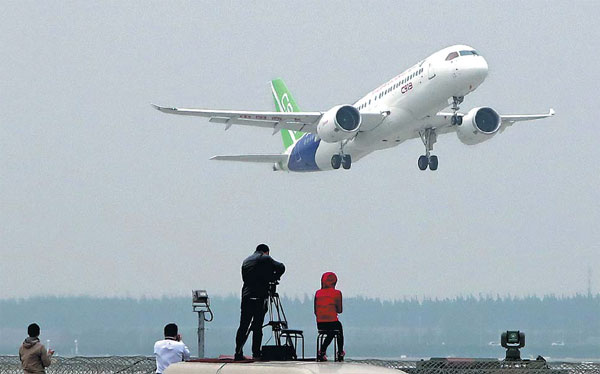Airliner's maiden voyage heralds industry's growing abilities
New C919 undergoes domestically developed tests to ensure safety, success
C919, China's first homegrown large passenger jet, completed its maiden test flight in early May. Before the 79-minute maiden journey, the jumbo aircraft had received quite a few functional tests on the ground - among them, the HIRF test.
HIRF, short for "high-intensity radiated fields", refers to radio frequency energy that is strong enough to adversely affect the performance of the airplane subjected to it.
Radars, radios, televisions and even passengers' cellphones that can generate HIRF are invisible killers for aircraft with electronic equipment sensitive to HIRF.
"It is a must for aircraft to have the radiation protection," said Zhang Yuan, a chief engineer at the 802 Research Institute at the Shanghai Academy of Spaceflight Technology. Zhang's team conducted the HIRF test on the C919, marking the first aircraft-level HIRF test performed by a domestic Chinese institution.
Electromagnetic interference during flight may even lead to failure of some electronic equipment, which could result in the crash of the aircraft, Zhang said.
Through their research on the test, the institute had filed seven invention patent applications by the end of 2016, two of them being approved. It also registered two software copyrights concerning the HIRF test.
The institute is working to improve its patent portfolio and expand its patent pool.
"Currently, aircraft-level HIRF testing is gaining more and more attention and has become one of the most significant tests before the maiden flight of an aircraft," he said.
During the test, the team overcame a great deal of difficulties, according to the institute.
According to the test requirements, they should perform a set of comprehensive tests on nine cabins and hundreds of cables from three different directions under various conditions within six days.
"When it comes to the HIRF test being performed on such a large-scale aircraft, we had zero experience," Zhang said.
The team applied a new system of optical and electric transformation using multi-channel optical fibers. New methods were also employed to simulate the even exposure of radiation on the craft.
Starting on March 1, the team began their week of 24-hour tests. They measured time in minutes and even seconds. After six days and nights, the sunrise on March 7 marked the completion of their task.
In 2011, the institute was assigned to the task of the HIRF test.
Liao Yi, PhD, a senior engineer at the institution and a key participant in the test, said: "Methods and techniques are crucial to the HIRF test. Though some of the equipment is imported, we completed the testing system integration, including a major part of software control and data processing, as well as algorithms, independently."
Each different model of aircraft - not only civil airliners, but also official aircraft and helicopters - should perform the HIRF test before their first flight, Liao said.
China sent the C919 into the sky on May 5, joining the ranks of the world's leading jumbo aircraft manufacturers.
liyou@chinadaily.com.cn
|
C919, China's first homegrown large passenger jet, completes its maiden test flight in Shanghai on May 5, marking the country's entry to the ranks of jumbo aircraft manufacturers around the world. Gao Erqiang / China Daily |



















